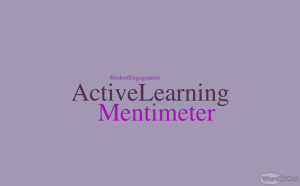 “Active learning engages students in the process of learning through activities and/or discussion in class, as opposed to passively listening to an expert” (Freeman et al., 2014).
“Active learning engages students in the process of learning through activities and/or discussion in class, as opposed to passively listening to an expert” (Freeman et al., 2014).
One tool that has made active learning more possible in my classes is Mentimeter.
Whether we teach a class in person or we teach an online synchronous course, Mentimeter can accommodate engaging large groups of audiences. If we teach a class implementing Bloom’s Taxonomy approach, Mentimeter can be a great tool in developing a successful and engaging lesson.
- The first step of learning based on Bloom’s Taxonomy is recalling and remembering facts and concepts; Mentimeter’s open ended or word cloud slide option could be used for step one.
- The second step of learning which focuses on identifying, describing, recognizing, or selecting information can also be carried out through the above mentioned features as well as through its multiple choice feature.
- In the third step, when learners need to apply their learning, Mentimeter’s open ended, paragraph, or scale’s features can be used.
- In the fourth step, when learners need to analyze information, they may still use the multiple choice, open ended, or its word cloud features.
- In the fifth step, while synthesizing data, learners can use the scaling feature of Mentimer.
- Finally, after the evaluation step is complete and when creating original samples of work in writing, learners can certainly use the open ended or the paragraph feature again.
Personally, I use Mentimeter when I start a class and want students to recall information and get them excited about a lesson – using it as a hook for my learners. I also use the tool when wrapping up and collecting student feedback on the learning experience for the day using the following question: “ How was your learning experience today? Do you have any questions, concerns, or suggestions?”. Finally, I use its word cloud feature for teaching and reinforcing vocabulary. Mentimeter can also be used when presenting in a conference or running a workshop, and the main advantage it brings to the learning environment is the various tools it offers for audience engagement.
These are my experiences with the tool, but there are far more ways that you may choose to implement it in your teaching, which Mentimeter elaborates on in its “Tools for Online Teaching”.
What are some tools you use to engage your students in active learning and keep them buzzed about their learning experiences?
References
Freeman, S., Eddy, S. L., McDonough, M., Smith, M. K., Okoroafor, N., Jordt, H., & Wenderoth, M. P. (2014). Active learning increases student performance in science, engineering, and mathematics. Proceedings of the national academy of sciences, 111(23), 8410-8415.
